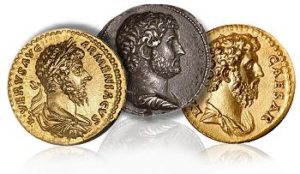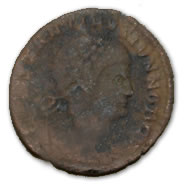Information on: finding ancient Roman coins for sale, coins in Rome civilization, coins for sale from ancient Rome
Coins used in Roman civilization and ancient Roman silver coins:
Right from the third century BC to the third century AD, in the Roman republic, the Roman currency comprised the coins of gold, silver, brass, and copper. The ancient Roman coins comprised the gold coins termed as the Aureus coins which were used widely in the transactions till the middle of the 3rd century AD.

The Denarius i.e. the silver coins were mostly used during third century AD. As per the records found in the numismatic libraries, the other coins which were very widely used in the western half of the Roman Empire were Sestertius and Dupondius coins.
Around the third century AD, the silver i.e. the denarius coins were substituted by the double denarius coins. In the later years, these coins were termed as antoninianus or radiate. The Silver coins were replaced as a result of the economic reforms of Diocletian.

In these reforms, the denominations like silver (argenteus) coins and silvered bronze (follis) coins were created. The Roman coinage consisted of the bronze denominations and the gold coins termed as solidus and this was followed until the end of the Western Roman Empire.
During the regime of Caser, the coinage was focused on the artistic impressions on the coins. The imagery that was usually seen during the empire was the portrait of the Emperor. Julius Caesar initiated the trend of embossing his own portraits on the coins and later it was followed in the preceding years. The image of the Emperor on the coins made them the main source of publicizing it throughout the Empire.
Roman Coins for Sale
The ancient Roman coins attract a huge mass of people who are fond of Numismatics. During the regime of Augustus Caesar, the Roman nobles who were very much influenced by Greek culture made a collection of Greek coins and antique articles and this led to the rise of the art of Numismatics.
Ancient Roman coins value
The ancient Roman coins gained a significant value in the numismatic fraternity. The Renaissance kahunas showed the readiness to pay a sizeable amount of money for these coins and for the artwork including the portraits of the emperor. This was the era that witnessed the first ever numismatic imitation that included Paduan medals that were carved by Cavino and various other contemporary artists.

In the numismatic libraries, you can find a wide array of ancient Roman coins for sale. Those in gold, silver, or those molded in two metals, have great demand around the globe. You’ll find a large variety in the category named after Caesar. Silver coins with twelve Caesar, Tiberius Caesar Gold coin, etc. are some of those.
The ancient Roman coins of 4th – 5th century BC include the crude metal coins with hand impressions. The Caesar coins had impressions of weapons, animals etc. other than his own portraits. Julius Caesar silver (denarius) coin which is molded in 49 BC has an elephant advancing right and it is trampling on the horned serpent.
A few coins with emblems that preach some fundamentals are also seen in different metals termed as aspergillum, Simpulum, apex and secured.




